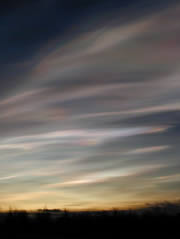Arctic clouds may cause a significant increase in the depletion of the ozone layer
Philip Ball, Nature (translation: Dikla Oren)

It is possible that a side effect of global warming will cause a severe depletion of the ozone layer above the North Pole, a depletion much higher than previously estimated.
If the upper layers of the atmosphere in the North Pole cool - a predicted result of climate change - the rate of depletion of the ozone layer may be three times higher than current predictions. This is what Markus Rex and his colleagues from the Alfred Wagner Institute for Polar and Sea Research in Potsdam, Germany claim.
"I was surprised to see these results," says Drew Schindel, an atmospheric researcher at NASA's Goddard Institute for Space Research in New York. "We didn't suspect for a moment, because our model is so far from reality," he adds.
Rex and his colleagues studied the climate conditions in the Arctic during the last ten winters to calculate the effect of weather on the destruction of the ozone layer. They discovered a close relationship between ozone loss and the amount of polar stratospheric clouds. A full report on the research appears in the journal Geophysical Research Letters.
These clouds form about twenty kilometers above the ground in winter, and are often called "pearl oyster clouds" because of their shimmering appearance.
However, these are not beautiful and harmless oysters: the clouds form a substrate for reactions between chemicals, which eat away at the earth's ozone layer. The chemical reactions in the clouds convert chlorine from industrial sources such as chlorofluorocarbon (CFC - ChloroFlouroCarbon), which is found in old refrigerators, into active derivatives of the substance, which break down the ozone molecules.
The destruction of the ozone allows more ultraviolet rays, which come from the sun, to reach the surface of the earth and cause damage to humans and the entire ecosystem in the polar region.
It is estimated that cold air in the stratosphere encourages the formation of these clouds and ultimately the destruction of the ozone, but estimating the extent of the problem turned out to be no easy task at all. On average, the stratosphere above the North Pole has not cooled significantly in recent years, yet Rex and his colleagues say that winter climate conditions are becoming increasingly suitable for ozone destruction. They add that the amount of stratospheric clouds has been increasing at a steady rate since the late 1960s.
If Rex's findings and models prove correct, all our estimates of the expected depletion of the ozone layer are too low, Schindel says.
There's also better news: Rex points out that even if stratospheric clouds continue to grow in both size and quantity, the amount of CFCs in the atmosphere should decrease over time as the molecules of the substance undergo changes. However, they will remain in the atmosphere for quite a long time and continue to cause ozone depletion in the coming decades.
